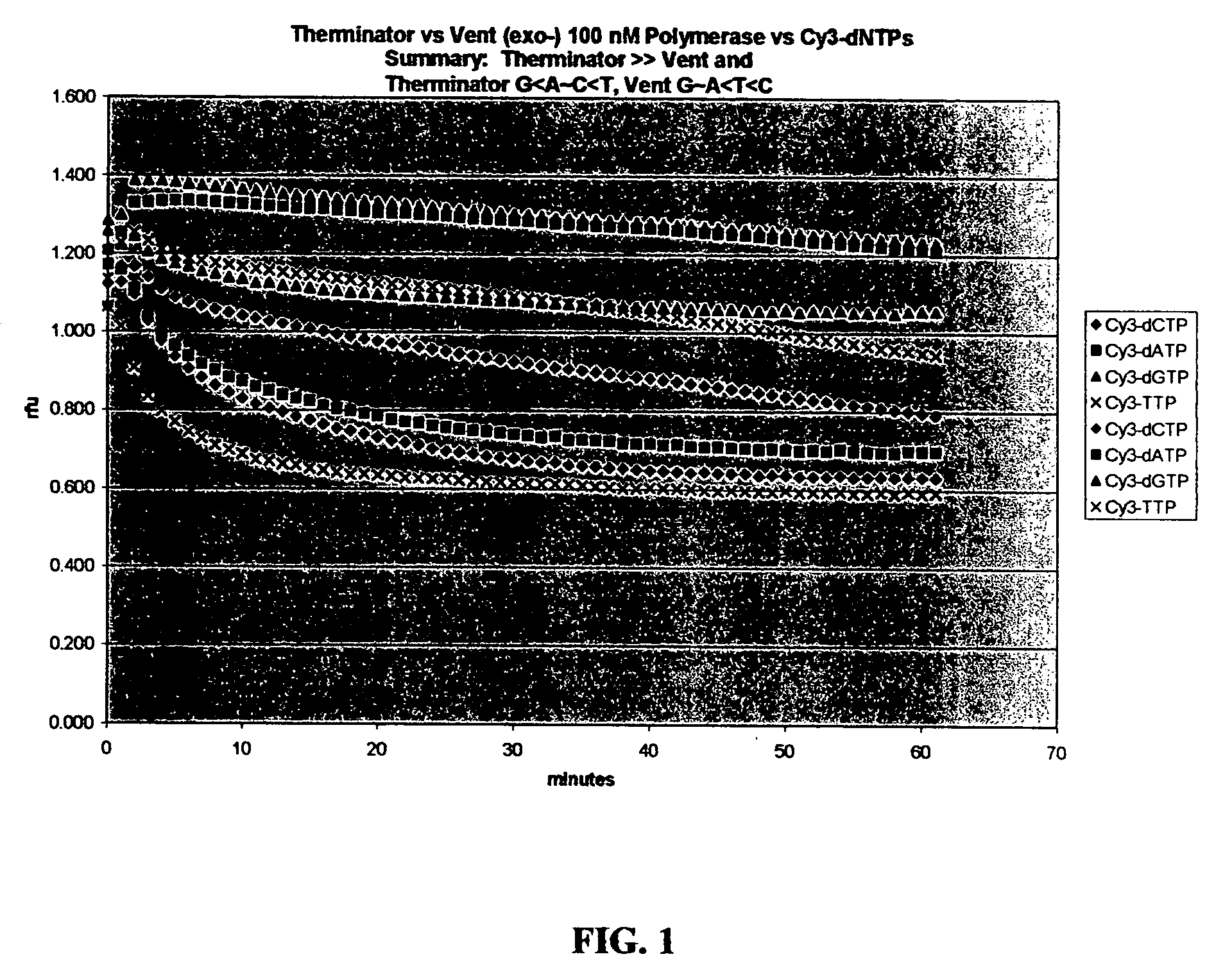Methods for nucleic acid sequence determination
a nucleic acid and sequence technology, applied in the field of nucleic acid sequence determination, can solve the problems of lack of cost-effective tools and methods, many challenges remain, and bulk sequencing techniques are not useful for the identification of subtle or rare nucleotide changes, and achieve the effect of increasing laser intensity
- Summary
- Abstract
- Description
- Claims
- Application Information
AI Technical Summary
Benefits of technology
Problems solved by technology
Method used
Image
Examples
example 1
[0034] Incorporation of Nucleotides using Polymerases in Single Molecule Sequencing
[0035] A target nucleic acid is obtained from a patient using a variety of known procedures for extracting the nucleic acid. Although unnecessary for single molecule sequencing, the extracted nucleic acid can be optionally amplified to a concentration convenient for genotyping or sequence work. Nucleic acid amplification methods are known in the art, such as polymerase chain reaction. Other amplification methods known in the art that can be used include ligase chain reaction, for example.
[0036] The single stranded plasmid can be primed by 5′-biotinylated primers, and double stranded plasmid can then be synthesized. The double stranded plasmid can then be linearized, and the biotinylated strand purified. Analyzing a target nucleic acid by synthesizing its complementary strand may involve hybridizing a primer to the target nucleic acid. The primer can be selected to be sufficiently long to prime the s...
example 2
[0046] Determining Processivity of 9° N A485 (exo-) DNA Polymerase in the Presence of Labeled Nucleotides
[0047] As a proof-of-principle to determine whether the 9° N A485 (exo-) DNA polymerase accurately incorporates labeled nucleotides into the primer, an extension experiment can be performed in a test tube rather than on a substrate. In this experiment, incorporation of dCTP-Cy3 and a polymerization terminator, ddCTP, can be detected using a 7G DNA template (a DNA strand having a G residue every 7 bases). The annealed primer is extended in the presence of non-labeled dATP, dGTP, dTTP, Cy3-labeled dCTP, and ddCTP. The ratio of Cy3-dCTP and ddCTP can be analyzed. The reaction products can be separated on a gel, fluorescence can be excited, and the signals detected, using an automatic sequencer, such as, ABI-377.
[0048] The presence of fluorescence intensity from primer extension products of various lengths which were terminated by incorporation of ddCTP at the different G residues ...
example 3
[0049] A screening process was established and the 9 degrees north A485L (exo-) DNA polymerase was tested in a bulk assay. As depicted in FIGS. 1 and 2, this polymerase was found to substantially outperform the Vent (exo-) polymerase. The 9 degrees north A485L (exo-) DNA polymerase is sold commercially by New England BioLabs (Beverly, Mass.) as “Therminator™ and by Perkin-Elmer (Boston, Mass.) in AcycloPrime SNP kits as AcycloPol™. As depicted in FIGS. 1 and 2, based upon the screening protocols, the Vent (exo-) polymerase and the 9° N A485L (exo-) DNA polymerase, which typically have optimal temperature ranges of 65-80° C. were found to perform satisfactorily at about 37° C. The activity of the 9° N A485L (exo-) DNA polymerase is shown as a function of relative fluorescence units over a period of time.
PUM
| Property | Measurement | Unit |
|---|---|---|
| temperature | aaaaa | aaaaa |
| temperature | aaaaa | aaaaa |
| temperature | aaaaa | aaaaa |
Abstract
Description
Claims
Application Information
 Login to View More
Login to View More - R&D
- Intellectual Property
- Life Sciences
- Materials
- Tech Scout
- Unparalleled Data Quality
- Higher Quality Content
- 60% Fewer Hallucinations
Browse by: Latest US Patents, China's latest patents, Technical Efficacy Thesaurus, Application Domain, Technology Topic, Popular Technical Reports.
© 2025 PatSnap. All rights reserved.Legal|Privacy policy|Modern Slavery Act Transparency Statement|Sitemap|About US| Contact US: help@patsnap.com


